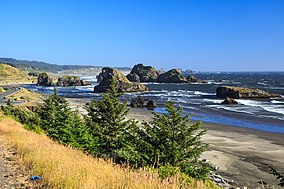| Oregon Islands National Wildlife Refuge | |
|---|---|
| IUCN category IV (habitat/species management area) | |
 Hunter's Cove Hunter's Cove | |
| Location | Oregon |
| Coordinates | 44°10′59″N 124°07′19″W / 44.1831763°N 124.1220644°W / 44.1831763; -124.1220644 |
| Area | 1,083 acres (438 ha) |
| Created | 1935 |
| Governing body | United States Fish and Wildlife Service |
| Website | Oregon Islands NWR |
Oregon Islands National Wildlife Refuge is a U.S. National Wildlife Refuge off the southwestern Oregon Coast. It is one of six National Wildlife Refuges comprising the Oregon Coast National Wildlife Refuge Complex. The Oregon Islands provides wilderness protection to 1,853 small islands, rocks, and reefs plus two headlands, totaling 371 acres (150 ha) spanning 1,083 acres (438 ha) of Oregon's coastline from the Oregon–California border to Tillamook Head. There are sites in six of the seven coastal counties of Oregon. From north to south they are Clatsop, Tillamook, Lincoln, Lane, Coos, and Curry counties. (Douglas County is the only coastal Oregon county not included in the refuge.) The area is managed by the United States Fish and Wildlife Service.
History
The Oregon Islands National Wildlife Refuge was created in 1935 by the federal government. Haystack Rock off Cannon Beach was added to the refuge in 1968, which became a wilderness area in 1978. The first mainland addition to the refuge came in 1991 when Coquille Point near Bandon was added. In 1999, the shipwreck of the New Carissa near Coos Bay spilled oil that killed some birds at the refuge.
Wildlife and access


It is a sanctuary for nesting seabirds of thirteen species—some of the most important nesting seabird colonies in the U.S. Over 1.2 million individuals nest in colonies here, more than on the California and Washington coasts combined. The most prevalent species are common murres, tufted puffins, rhinoceros and Cassin's auklets, pigeon guillemots, Leach's storm-petrels, several species of gulls, and Caspian terns.
Four species of pinniped breed, molt, and rest on these lands, including harbor seals, Steller and California sea lions. The southern portion of the refuge provides the greatest number of breeding and pupping sites for Steller sea lions in the U.S. outside Alaska.
Except for Tillamook Rock Light and its surrounding 1-acre (4,000 m) rock, all the islands are closed to public access. Boats must remain at least 500 feet (150 m) away, and aircraft are asked to maintain at least 2,000 ft (600 m) clearance. However, good viewing is possible from Coquille Point in Bandon and other locations suggested by the Oregon Coast Birding Trail.
See also
- Pacific Flyway
- Important Bird Area
- List of National Wildlife Refuges in Oregon
- List of Oregon Wildernesses
- Wilderness Act
- List of U.S. Wilderness Areas
References
- "Oregon Islands National Wildlife Refuge". Geographic Names Information System. United States Geological Survey, United States Department of the Interior.
- ^ "Annual Report of Lands as of September 30, 2009" (PDF). United States Fish and Wildlife Service.
- ^ "Oregon Islands Wilderness". Wilderness.net. Retrieved September 14, 2007.
- "About the Refuge". United States Fish and Wildlife Service. August 19, 2015. p. 1. Retrieved March 26, 2020.
- Tobias, Lori (May 18, 2007). "Local guardians of Haystack Rock look for backup". The Oregonian.
- Henderson, Bonnie (July 1992). "The wild worlds of the Oregon coast". Sunset. Retrieved September 18, 2007.
- ^ Hill, Richard L. (March 14, 1999). "Spill has no mercy on Oregon seabirds". The Oregonian.
- "Oregon Coast National Wildlife Refuges" (PDF). United States Fish and Wildlife Service. October 12, 2000. p. 6. Retrieved September 14, 2007.
- ^ "Oregon Islands National Wildlife Refuge". United States Fish and Wildlife Service. Retrieved September 14, 2007.
- ^ "Welcome to the Oregon Coast National Wildlife Refuge Complex Home Page!". United States Fish and Wildlife Service. Retrieved September 14, 2007.
- "Help Protect Marine Wildlife" (PDF). United States Fish and Wildlife Service. Retrieved September 14, 2007.
- "Pilots: Please Help Protect Marine Wildlife in Oregon" (PDF). United States Fish and Wildlife Service. Retrieved September 14, 2007.
External links
| National Wildlife Refuges of the United States | |
|---|---|
|
- IUCN Category IV
- 1935 establishments in Oregon
- Islands of Oregon
- Landforms of Clatsop County, Oregon
- Landforms of Coos County, Oregon
- Landforms of Curry County, Oregon
- Landforms of Lane County, Oregon
- Landforms of Lincoln County, Oregon
- Landforms of Tillamook County, Oregon
- National Wildlife Refuges in Oregon
- Oregon Coast
- Protected areas of Clatsop County, Oregon
- Protected areas of Coos County, Oregon
- Protected areas of Curry County, Oregon
- Protected areas of Lane County, Oregon
- Protected areas of Lincoln County, Oregon
- Protected areas of Tillamook County, Oregon
- Wilderness areas of Oregon
- Protected areas established in 1935